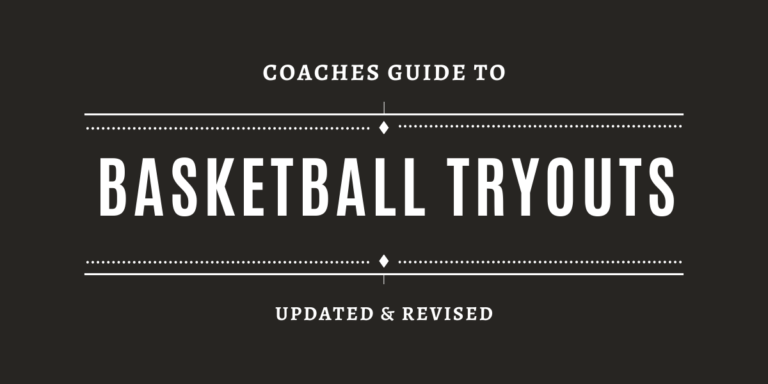4 Key Phases of Basketball
Heading into a new season you can give your team an advantage over your opponents. You can prepare them in the four key phases of the game so they are ready to compete with teams that may look better than you on paper.
Most coaches only focus on two of the four phases of the game and this is their downfall but can be where you’ll be able to steal the momentum and come up with big plays in important games.
Each phase has more or less importance to every team depending on their style of play and the style of play of their opponent. But no matter what the style of play for either team, the four phases always exist and should be developed by your team.
As we dive into each phase you need to ask yourself two crucial questions:
1. What is my philosophy and system for each phase of the game?
2. What is the philosophy or system of my opponent?
Both questions will help you develop a game plan for your team to execute and help to create a game plan for attacking your opponent.
Phase One: Half-Court Offense
Half-court offense is the most thought about phase of the game by coaches and players. On social media I get the most likes and shares on posts that deal with a play or action in the half court offense. Posts on other areas, no matter how important, never get the same attention.
Whether you played basketball in college, came up under a great head coach, or are developing a system of your own, there are some key questions to ask yourself when dealing with the half-court offense phase of the game.
What kind of players do I have?
What style of play am I comfortable coaching?
What will allow us to compete with the best teams on our schedule?
The answers you come up with will have a lot to do with the type of players you have and the coaching style you subscribe to. Don’t be afraid to think outside the box as there are many options that may fit what you and your team are need.
Offensive Options
Continuity Offenses – Wheel Offense, Flex Offense, Shuffle Cut
Motion Offenses – Dribble Drive, Read and React, Basic Motion
Set Offenses – 1-4 High, Box Set, Diamond Sets
By no means is this an exhaustive list, it just goes to show there are several options for you to consider when selecting an offense. As a way to help coaches discover which offense they may want to use I provide an Offensive Systems inside the Coaching Library of the Coaching Lab.
My Phase 1 Philosophy: Motion Offense – my teams use space, pace, shot selection, and ball reversals to score points. I believe this is the toughest offense to scout and gives us an advantage when we share the ball and know how to find advantages.
Phase Two: Transition Defense
The second phase to look at is what happens after your half-court offensive possession is over.
While many coaches like to utilize a press or set-up their half-court defense after a made basket its the missed baskets that can create the most chaos. It’s my opinion that transition defense after a missed shot is one of the least understood phases of the game. The focus of the next few paragraphs will deal with transition defense after a missed basket.
The line of thought that players only need to get back and protect the hoop is the most popular transition defensive tactic, and may be the only tactic used by some teams. This is obviously a key component of getting back and playing defense in the half-court, but it’s not the only way to utilize transitioning from offense to defense.
Ideas on Transitioning From Offense To Defense
A big question you need to ask yourself is, “What do I want my defensive transition to do?”
- Slow the ball.
- Disrupt the fast break.
- Get the ball out of the point guards hands.
- Set-up my half court defense.
- Take away the lay-up.
- Take away an open 3 point shot.
All of these options are notable and worth exploring, but ultimately your defensive transition needs to be focused on only a couple of these options and not all seven.
Transition Defense Begins…
Coaches also need to determine when they believe transition defense begins…
- …once a shot is put up.
- …once the other team has the ball.
- …once the other team is in a scoring position.
- …once the ball is crosses half court.
This begs the question, when do you want to apply pressure on the ball and pick up the other teams players?
- Get Back and Cover The Hoop (all 5, only 4, how may get back?)
- Get Back and Cover An Open Space (basket, wings , free throw, top of the key)
- Pick Up The Ball At Half-Court
- Pick Up Everyone At Half-Court
- Pick-up the Ball Full-Court
- Pick-Up Everyone Full-Court
The philosophy and system you decide to use does not have to be fancy, it only needs to be enough to stop (or at least slow down) the transition offense of the other team.
I’ve heard many coaches yell at a player to pick up the ball or ask why they didn’t stop the player from driving to the basket. I truly believe that most of these players were not coached to do what the coach is asking of them. There is a communication breakdown between the player and the coach in what each thinks the players responsibility is in transition defense..
My Phase 2 Philosophy: On missed shots, we like to pick up the ball full-court so our opponent doesn’t have time to get comfortable and set-up their offense. On a made shot, we full-court press for the same reasons as we pick up full court on a missed shot. I don’t like the offense getting comfortable in transition.
Phase Three: Half-Court Defense
If the opposing team gets the ball down the floor and has to set-up a half court offense you then need to have a solid plan for phase three, half-court defense.
Like half-court offense there are a lot of coaches who hang their hat on their team’s ability to play solid half-court defense. It doesn’t matter if it’s a zone or man-to-man, half-court defense is important and gets a lot of attention. Similar to half-court offense, I think a coach needs to look at their team and determine what types of players they have and what type of defense they can be successful with year in and year out. This may be a mixture of zone and man defenses or adjusting your man-to-man defense from a pressure defense to more of a sagging defense.
Defensive Options
Zone Defense – 1-3-1, 2-3, 1-2-1, 3-2, Point Zone
Man-To-Man Defense – No Middle, Force Left, Pack Line, Force Baseline
Hybrid Defenses – Triangle and 2, Box and 1
There are other defenses your team could utilize as well, along with various tweaks to make them as successful as possible against your opponents. The biggest thing a coach needs to do with their defense is get their team to buy-in to whatever defense they decide to play. When you get your players to play hard it’s amazing what they are capable of accomplishing together.
Here are the key area you need to make sure your defense focuses on.
3 Characteristics of Great Half-Court Defenses
- Working Hard – great defenses know how to work, work, work
- Communication – great defenses communicate a lot and loudly
- Move On Air Time – great defenses move on the pass and the shot
If you’re looking for defensive drills and concepts or you want to explore a more in depth study of defensive systems check out what the Coaching Lab has to offer.
My Phase 3 Philosophy: Force Baseline Pressure man-to-man defense. We like to try and make the court small for our opponents and get them to make decisions and shots in tough situations. You can learn more about my Force Baseline Pressure Defense by clicking here.
Phase Four: Transition Offense
Last, but certainly not least, is phase four: transition offense. Much like transition defense a coach needs to decide when and how their transition offense will start. Some coaches only like their point guards to bring the ball up the floor and make decisions. While other coaches like the first available ball handler to streak ahead and try to make a play. There is no right or wrong way to transition into your offense, but having your whole team on the same page is vitally important to your teams success.
We’ll spend our time looking at transitioning to offense after an opponent misses a shot in this phase and not on taking the ball out of bounds after a made shot.
On a missed shot a team typically begins looking for a fast break and then moves into a secondary break or early offensive action. If a team does not have and early offense option they may go into a quick hitter to a key player or directly in their half-court offensive set.
Transition Offense Options
Fast Break – Sideline Break, Two Sided Fast Break, Numbered Break
Early Offense / Secondary Break – Carolina Secondary Break, MSU Early Offense
Quick Hitters – ball screens, post-ups, flex cuts, shuffle cuts, variety of other quick hit actions
Many of these options along with several others can be found inside the Offensive/Defensive Transition section of the Coaching Library.
My Phase 4 Philosophy: Uptempo combination of the numbered break and the two side fast break. Depending on who rebounds the ball we change from a numbered break where everyone runs their lane to the two side fast break to open up the floor more.
Other ideas to consider in your transition offense are:
- How fast do you want to push the ball?
- Would you like the ball in the middle of the floor or on the sideline?
- What spacing should your team have?
- Should your big man run to the rim to post up, move over to the dunkers sport in the short corner, or trail the play?
- All of these questions can add potential scoring opportunities depending on the personnel you have this year.
As I mentioned in the defensive transition phase, there aren’t a lot of teams that focus on defensive transition. This means the more prepared and disciplined your offensive transition is the easier your team will be able to find shots and get easy baskets.
The Importance Of Every Phase
Each phase of the game is important and needs to be given its appropriate time in practice. The moment you ignore one phase you’ll come up against an opponent who excels in the opposite area and exploits the miscommunication, lack of organization, or misunderstanding of the five players on the floor.
Making sure you have a basic philosophy and system in all four phases of the game that is communicated to your team. Having a solid understanding of these 4 Key Phases of Basketball is vital to your team competing and finding lasting success throughout a game and season.
To explore new options in each phase or to better understand what you and your opponents are using join me inside the Coaching Lab.







